|
Danzig-Wonneberg / Gdansk-Ujescisko
|
This is a private page of nostalgia,
which has nothing to do with mathematics.
.
Introduction
...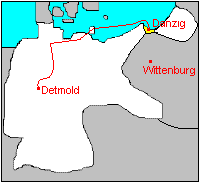 ... ... |
I spent my first eight years from 1937 to 1945 at a small
village south of Danzig with the name Wonneberg, now Ujescisko.
My parents grew up at Wittenburg, Kreis Briesen. In 1930
my father came to Wonneberg as a young teacher and organist and started
a family.
We left Wonneberg in January 1945.
I returned to Wonneberg as a tourist in 1970 and 2006. |
In September 2008 I got connections
to two inhabitants of Ujescisko, Tomasz Zukowski and Jacek Kalinowski,
with help of the site http://www.ujescisko.com. They were
interested in the history before 1945. So I looked back and made this page.
In the meantime (May 2012) the site is closed. I would
like to run this web page, which originally should be a supplement of the
Polish site, further for several reasons.
Surroundings
of Wonneberg / Ujescisko top
...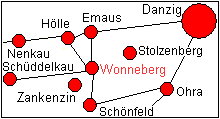 ... ... |
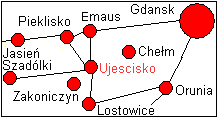 ... ... |
Surrounding villages in German and Polish. |
Maps top
Map of 1784
...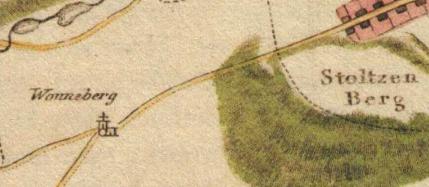 ... ...
|
Wonneberg is a very old village.
It is already drawn on a map of 1784. |
You can even go back to the
14th century:
You can read on the page Preußische Regesten (Regesten=collection
of documents) about 1341:
PrUB 3.423 — [1338-1341]
"Der Komtur von Danzig Winrich von Kniprode verleiht
dem Konrad Münzmeister als Schulzen das Dorf Wonneberg (Kreis Danziger
Höhe) mit 38 Hufen zu kulmischem Recht."
Quelle: http://www.prussia.uni-erlangen.de/1341.html#1341
This is a hint that Wonneberg
is a foundation of the Deutschritterorden.
Old
Map
...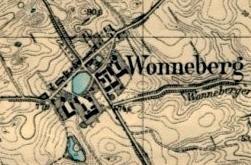 |
Wonneberg 1918
 |
Map
of the time after Wold War II
Wonneberg
heute mit Google Maps
Angerdorf
...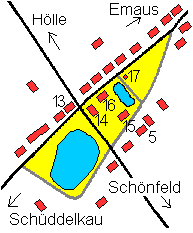 ... ... |
This is special: Wonneberg was an Angerdorf.
A main and a side street formed an island, the Anger (yellow).
There were three of the official buildings of the village,
the shop/pub (14), the school (15) and the smithy (16).
Then there were a small and a big pond, a meadow and
the pump house (17).
Most of the people took their drinking water from there.
This was the place to meet and to talk to each other.
There were five farms (5000 ha altogether) on the right-hand
side, the workers lived on the left-hand side. Most of them worked on the
farms.
The church (13) was outside the Anger on the main crossing
of the village.
Usually the church was also situated on the island of
an Angerdorf. |
Inhabitants
of Wonneberg top
We, my two elder brothers and I,
tried to make a list of all inhabitants of Wonneberg and to find their
new homes after the war.
.. .... .... |
A big help was the "Heimatortskartei für Danzig-Westpreußen
(1936-1963)" (=register).
Obviously nearly all inhabitants got in touch with this
place in Lübeck and sent them their address before and after 1945
in handwriting. |
The Heimatortskartei is located at the "Lastenausgleichsarchiv
des Bundesarchivs" in Bayreuth now. I made contact with them. You can only
look at it there.
You can also find the Heimatortskartei
in the Mormone's library. It is good luck that James Smith of the
Lademann family from Wonneberg could provide the microfilm with the datas
and send them to me in the form of 76 pictures. The numbers with two digits
in the following list is the number of a picture. The families with xx
are missing in the collection, but we knew them.
There are also family names from Neu-Wonneberg, which
we don't know with the exception 75 Herrmann. Then there is a card of the
innkeeper of Hölle, 14 Puttkammer, and the one of my first teacher
02 Miss Tschiersky, who taught in Hölle, but lived in Danzig.
This web page has been online
now (07/2013) for 5 years. Members of several families found this web page
and enlarged it or corrected errors.
We succeeded in finding the
names of about 42 families, who lived in Wonneberg before 1945.
xx Archut
59 Beyer
xx Cozch
64 Dombrowski
65 Domrös
66 von Dühren, Artur (Wirt)
67 von Dühren, Felix (Bauer)
xx Flissikowski
xx Grabowski
70/71 Grocholl
71 Groddeck
72 Hahn
12 Prang |
xx Richert
37 Hansekowski
74 Heering
47/48 Hinz
49 Hoffmann
49/50 Hübner
56 Köller
29 Konrad
xx Krause
xx Krönke
31 Krüger
33 Lademann
34 Lehre |
35 Liesandt
36/38/39 Lischnewski
40 Mahlau
43 Mirau – Sielaff
xx Pawlowski
xx Rosalewski
xx Rosengarten
16/18/19/20 Rösner
xx Siek
xx Spell
22 Splanemann
23 Splitt
xx Stolp |
01/28 Taube
03/04 Wittstock
06 Ziebarth
06 Ziehm.
.
.
.
.
.
.
.
. |
...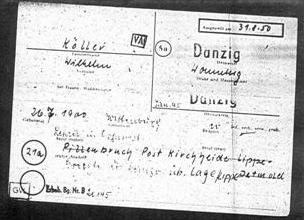 ... ... |
My father's card was also among them. You can possibly
read it. The quality is often bad, because words written with ink were
copied.
The card gives informations about:
Name
Day and place of birth, religion,
family status
Profession
Last residence before 1945
Addresses after 1945
|
Sometimes there is another card with the wife's and children's
names.
Houses
before 1945
The attempt follows to assign the families to the houses.
...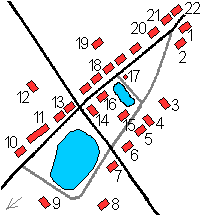 ... ... |
01 Wittstock
02 Hahn
03 Farmer Hering, Mrs. Schwarz
04 Farmer Groddeck, Lehre
05 School 1st to 4th year (Ms. Schäfer).
06 Farmer Taube
07 Farmer Arthur von Dühren
08 Farmer Prang
09 Sielaff, Mirau
10 Splitt
11 Worker's' houses:
Konrad, Domrös, Pawlowski, Dombrowski, Rosalewski,
Rosengarten, Ziehm(?). |
12 Mrs. Rösner
13 Parish priest house Hoffmann, Church
14 Shop and pub von Dühren
15 School 5-7 Köller
16 Smithy Archut, Liesandt
17 Pump house
18 Workers' houses - Splanemann, Mahlau, Hansekowski
/ Grocholl, Flissikowski, ...
19 Mahlau
20 House owned by the village - Sieg, Lademann and the
policeman Krüger.
21/22 Cozch, Lischnewski, Hübner, Ziebarth, Krönke,
Richert |
There is a gap between 2 and 3. This was the ground (1ha),
which belonged to the teacher.
Leaving Wonneberg top
We and only some families left Wonneberg before conquered
by the Russian army.
Attempt of Using the Train
...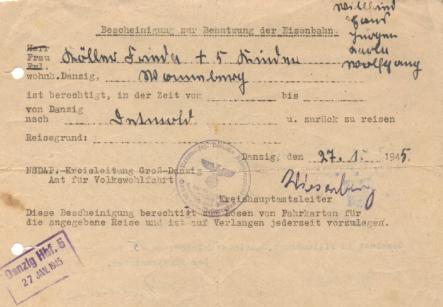
|
We wanted to go westward by train.
This is the ticket written in 1945, 27 Jan.
But the train returned to Danzig after some hours for
reasons whatever.
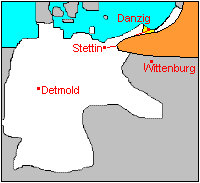
|
Over
the Baltic Sea
... ... ... |
Only the seeway was open. We found the ship Emsstrom,
which stayed in the harbour of Neufahrwasser until a convoy had assembled.
I found this statement about it on the internet:
"Am 1.Februar 1945 verließen die großen Passagierdampfer
Hansa (21.133 BRT), Hamburg (21.691 BRT), Cap Arkona (27.571 BRT) und weitere
Schiffe die Danziger Bucht und erreichten die westliche Ostsee."
The passenger liner Wilhelm Gustloff, where we got no
place, left Gotenhafen on its own with about 10.000 people on board already
in January 30, 1945 and sank on the same day. |
Most inhabitants stayed in Wonneberg and had to live under
Russian and then Polish administration.
These were hard times. Many of them left Wonneberg still
in 1945. All Germans were banished in 1947/48 except they became Polish.
Only two families stayed upon my investigations.
End
of War top
Wonneberg was occupied by the Russian
army on March 25, 1945. (Source: http://www.389id.de/Kampfhandlungen/Kurland.htm)
The inhabitants had to leave before the fights and were
allowed to return after 10 days. Then several houses were destroyed or
occupied by Polish families.
The date is confirmed by
Dmitri Turenkov, the grandson of the commander of the Russian 59th tank
brigade.
He discovered this web page and wrote inter alia: "I
am a grandson to the commander of 59th guards tank brigade...
Wonneberg was taken on March 25th, at 19.30, by the
3rd battalion of 59th guards tbr. Feel free to mention my grandfather's
name on your growing page: guards colonel Afanasy Turenkov, the commander
of 59th guards tank brigade of the 8th guards tank corps. Decorated with
7 orders, wounded 4 times."
After
the Potsdam Agreement
...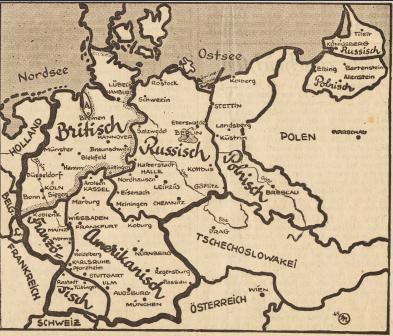 ... ...
|
This newspaper cutting was interesting for the Germans
and worked the beat in that time.
Thus Germany was reduced and thus the German Reich was
splitted. |
1.5 million people were brought
to the western Baltic Sea on this way up to April 1945, 3000 people died.
1937
and 1945
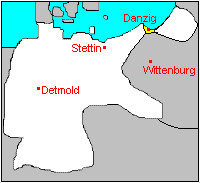
1937
|
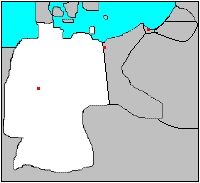
Today
|
Germany lost 1/3 of its areal. There were nearly seven millions
of refugees.
This was one price we had to pay because of our Nazi
regime, which had brought so much horror and evil to the world.
The bad times
after 1945 top
...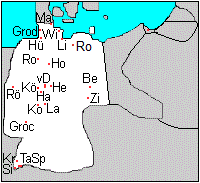 ... ... |
We found the new residences of 22 families.
The residence is marked by a red point. The letters are
the first ones of the family names.
This is sure:
The families spread out all over Germany after war and
had to restart at the place, they were sent to.
You can imagine: Refugees were not welcome. |
...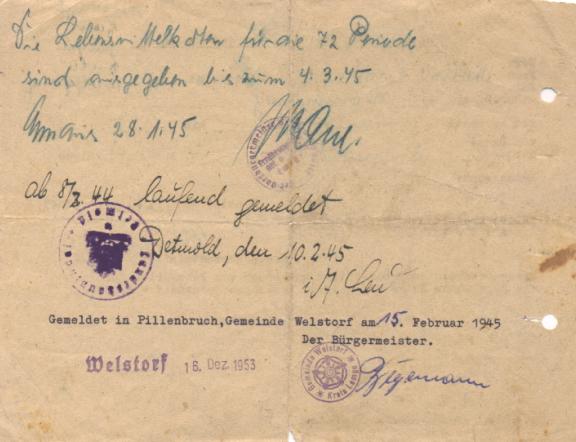 ... ... |
We came to Lippe-Detmold.
This is the Bezugsschein für Lebensmittelkarten
(licence to get food cards), issued in Danzig-Emaus and in Lippe. |
My parent subscribed to three
newspapers for refugees against being homesick.

My father ordered a bottle
of Machandel and one of Danziger Goldwater by mail order selling several
times. We teased him: We couldn't remember that he had bought these specialities
of Danzig before 1945.
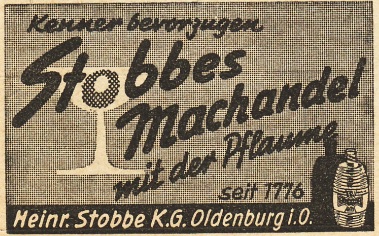
Anzeige von 1951
|
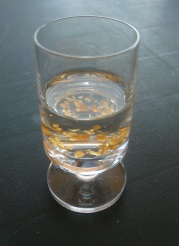
Danziger Goldwasser heute
|
There are a number of books
as heritage of my parents. It is interesting that there are two yearbooks
1950 of the old and the new home. I interpret this as a sign that they
had accepted their new home.
I called this chapter "The
bad times after 1945". This was the name not only in our family.
Maybe you understand this name, when I write down what
happened in our family from 1945 to the first 1950s and then no more.
> Cooking sugar beets, pressing
out the juice, and cooking it for hours until syrup develops
> Collecting wild raspberries and blackberries for making
jelly
> Eating rutabaga soup or bird cherry soup
> Collecting ants in sugar and fishing maggots from the
surface of pea and barley soup
> Collecting spikes on the empty fields and exchange
them to flour.
> Collecting beechnuts and exchange them to oil
> Eating the young leaves of the weeds ground elder as
lattice
> Making of a rabbit hutch, feeding and slaughtering
them
> Being content with a slice of bread daily and completing
with bitter corn bread
> Taking an empty can to school and taking part in free
school meals as a "refuguee child". Thank you, dear Quakers in the USA.
> Growing tobacco for father's consumption
> Roasting barley, grinding, and making coffee (Muckefuck)
of it
> Walking in wooden shoes
> Riding a bike with iron spirals instead of rubber tires
> Subscribing the communist newspaper VOLKSECHO and keeping
it as toilet paper
Later we could order the FREIE PRESSE.
> Using a colander made from a steel helmet
> redying the Nazi ensign or parachute silk and making
clothes of it
| > clearing stumps und using them as firewood
I still today respect my father's earth hoe. |
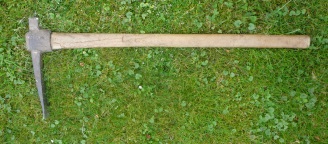 |
|
Wonneberg
/Ujescisko today
The German Wonneberg got the Polish name Ujescisko
in 1945.
...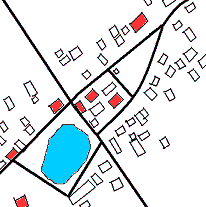 .... .... |
I tried to draw a plan of the village in 2006.
We recognized the red houses mostly built in red bricks.
The church was partly destroyed in 1945 and later taken
down.
There are trees, where the cemetery once was.
We could not recognize the farms. Many houses were destroyed
in 1945 at the end of the war.
The small pond is filled up, the pump house disappeared.
Now there are a transformer house and the bus station of Ujescisko.
The school, the smithy and the shop/pub had become apartment
houses. |
The houses of Wonneberg lay around the Dorfanger. Today the
village as a part of Gdansk has grown in all directions. There are also
many new settlements on the way to Lostowice (Schönfeld) and Zakoniczyn
(Zankenzin). So the traffic was dense in 2006. We could hardly cross the
streets.
In the meantime (2013) Wonneberg
had grown more and even belongs to the light-rail system of Danzig.
Lidl and Netto have opened their supermarkets.
Old Pictures
of Wonneberg top
Two postcards
Fortunately a postcard with the
church and a view of the main street is saved.
My mother wrote it to her cousin
in Mühlheim/Ruhr in 1942.
...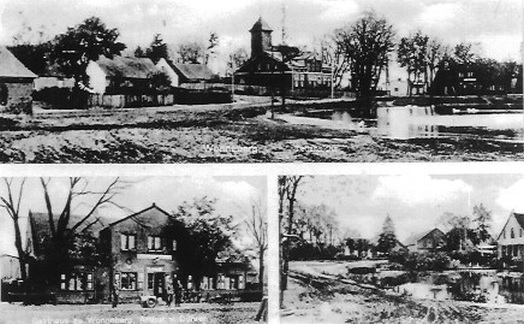 ... ... |
In December 2019 Gudrun Kirstein from the Rosengarten
family sent me a second postcard of Wonneberg.
There is the big pond and the church, the small pond with
the school at the far right below on the right, and the pub von Dühren
below on the left. |
Sketch
of the church surrounding
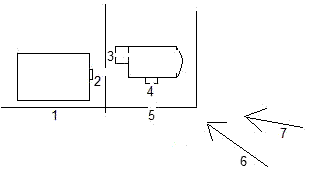
|
1 Vicarage
2 Entrance
3 Entrance to the steeple
4 Main entrance to the church
5 Fences surrounded vicarage, church und cemetery
6 View to the church on the postcard
7 View to the main street on the postcard |
...
I found this drawing on the internet
once
|
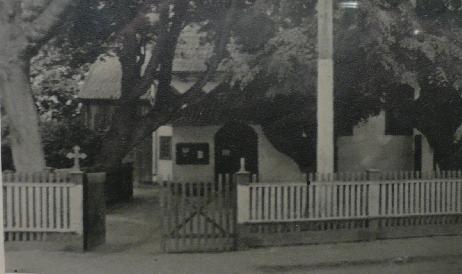
Entrance of the church before 1945
|
Gudrun Kirstein also sent
me a photo from the inner church.
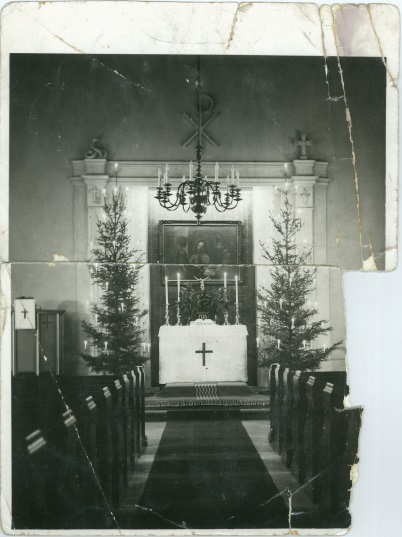
The
cemetery
When I visited Wonneberg in 1970,
many ruins of gravestones lay about. I couldn't find a German name.
Arne Vollmann sent me an email.
"Yesterday I got the photo of the gravestone of the last
resting place of my great-great-granduncle Friedrich Puttkammer and his
wife Alwine from Christinenhof. The Polish genealogist told me that the
former cemetery will be cleaned by "good spirits".
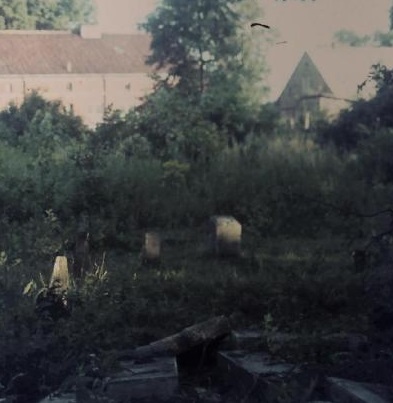
1970
|
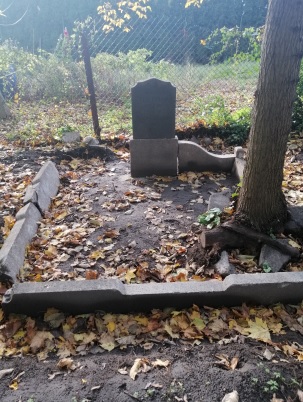
October 2019
|
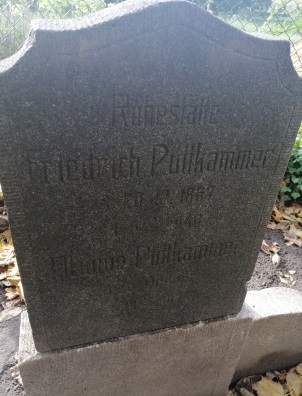
October 2019
|
School
...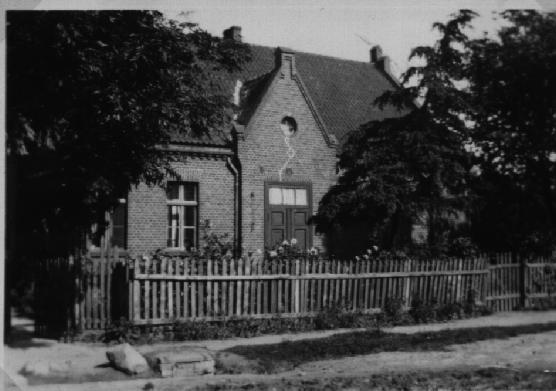 |
Former school (15) in 1930 |
...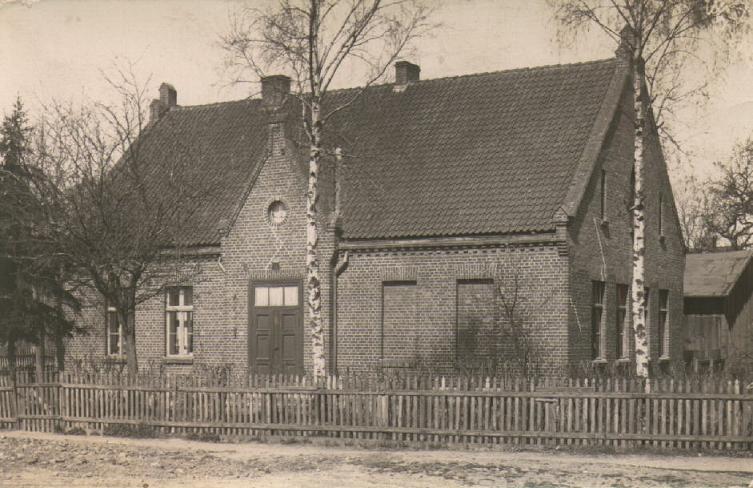 ... ... |
Former school (15) in 1939 |
The
von Dühren family
Kirsten Mrosseck found this page
on the internet, because she knew that her grandmother was brought up in
Wonneberg as the daughter of the smith Paul von Dühren. She
found a photo from 1918 (!) of her family in front of the smithy (Number
16 in my drawing).
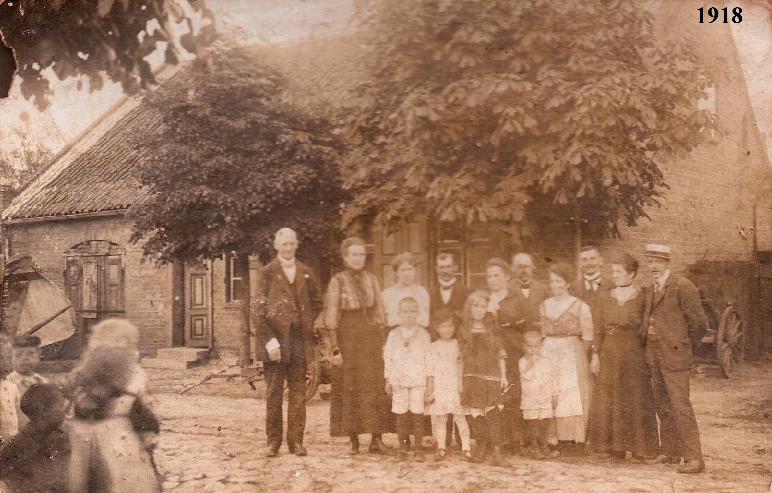
...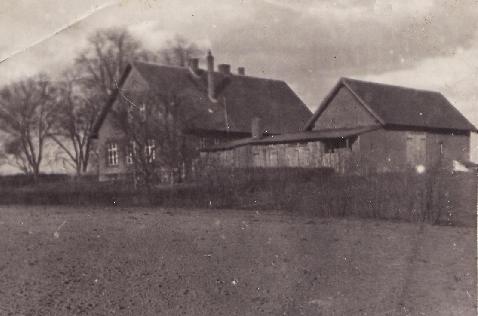 |
Farm Felix von Dühren before 1945
(7)
Rainer Köller sent me this photo. |
The
Heering family
Karin White, née Heering,
discovered this web page in November 2009. She is Franz und Dora
Heering's daughter, who owned a farm and a sandpit
northwest of Wonneberg. The sandpit was replaced by a large cemetery.
The buildings of the farm were destroyed during the fights
around Danzig in spring 1945.
When I visited the village in 1970, I only found the
former administrator's house. The beech tree on the left belonged to the
former garden.
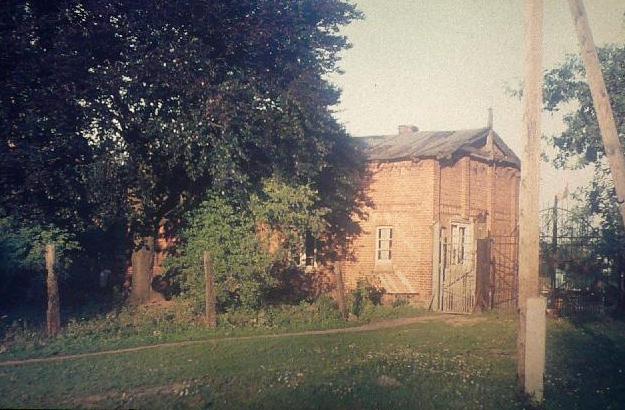
...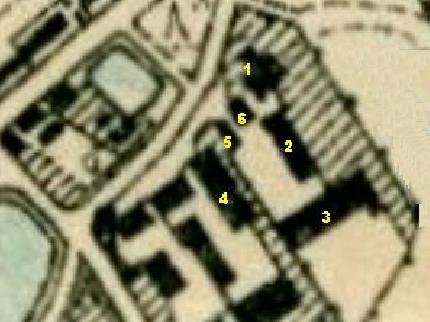 ... ... |
You can see the position of the farm buildings with the
help of the old
map from 1918.
1 dwelling, 2 cow shed and pigsty, 3 barn, 4 horse
stable, 5 room for carriages and smithy, 6 administrator's house. |
Karin sent me some photos.
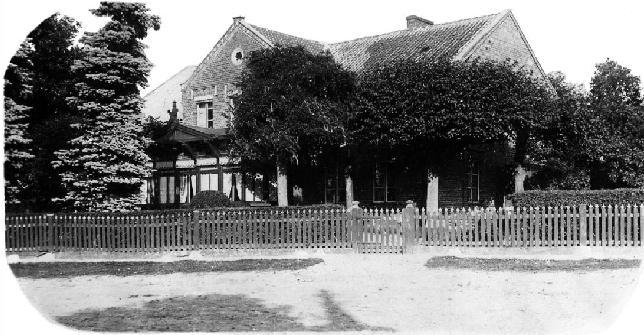
Dwelling
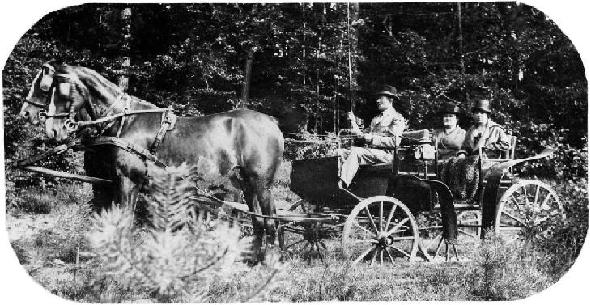
Franz Heering, Frau Schwarz, and Dora Heering on their
carriage

Franz Heering in front of the stable in 1932
Maybe the following two photos were taken in the village
in former times.
...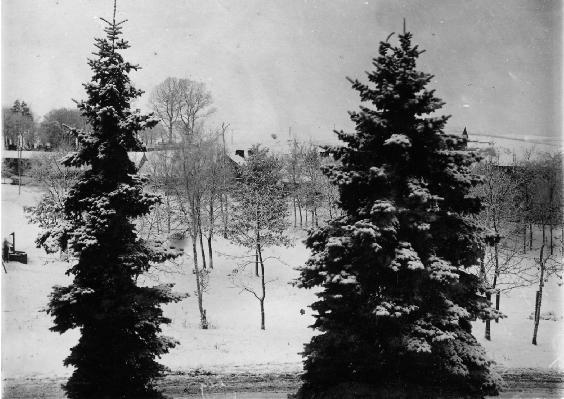 ... ... |
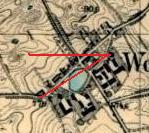
This is a photo taken from the first floor of the dwelling.
You see the school with the two chimneys in the centre.
The spire of the church is just right beside the fir
tree on the right.
The scattering of trees and the fountain on the left are
unknown.
|
We have a better feeling in the interpretation of the following
photo.
...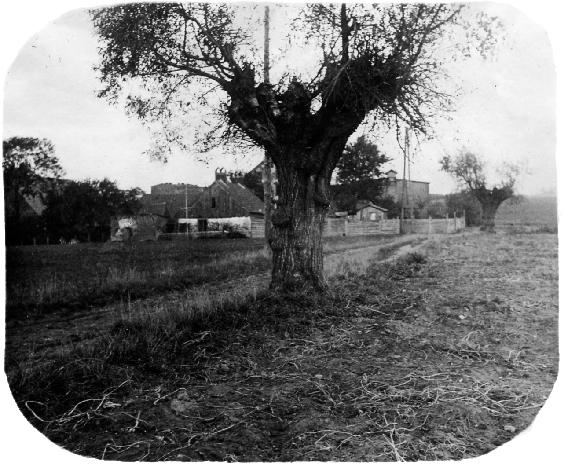 ... ... |
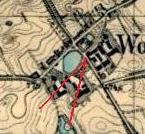
This is a view to the farm Prang with a chimney and to
two willow trees, which stood along the big pond.
Felix von Dühren's farm is on the very left.
|
The
Mirau family
I contacted the grandchildren of
the Mirau family (9). There are still two old photos in their family.
It is unkown, how old they are
and who are the persons on the first photo.
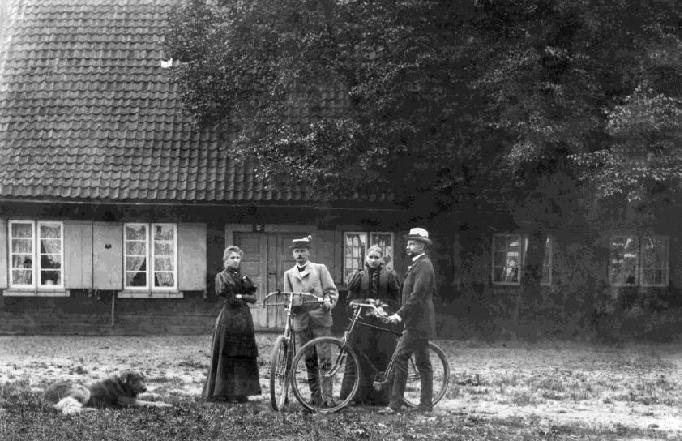
The house of the von Dühren family (14) in
the background, the shop on the left, the pub on the right.
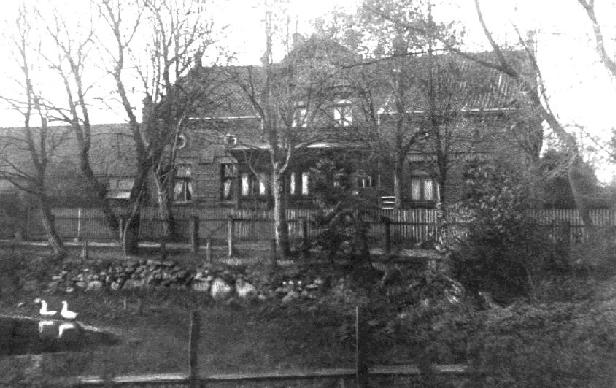
House of the Mirau family
The
Groddeck family
Stefan Busse, Mrs. Groddeck's nephew,
contacted me in June 2015. He provided the following photos.

Dwelling house and entrance to the yard
|
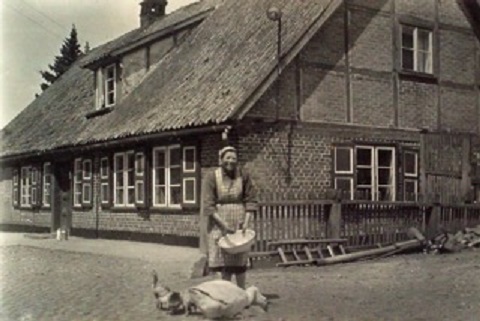
Dwelling house - view from the yard
|
Newer
photos
This is history, too. You can still see the pump.
...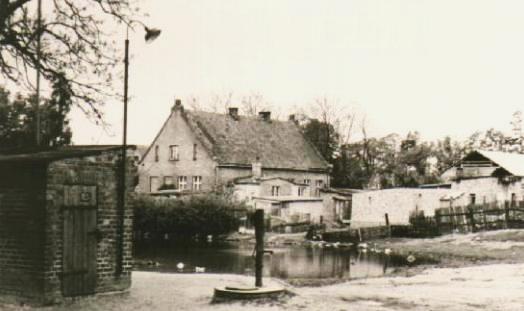 ... ... |
View from the pump house over the small pond to the former
school (15) in 1965.
Georg Hahn took it in 1965. |
...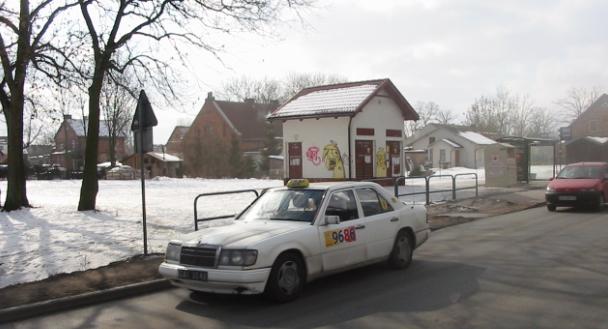 |
This is the same place in 2006. |
Old
Photos of places in the surrounding top
... ... ... |
 ... ... |
Surrounding villages in German and Polish. |
Zankenzin
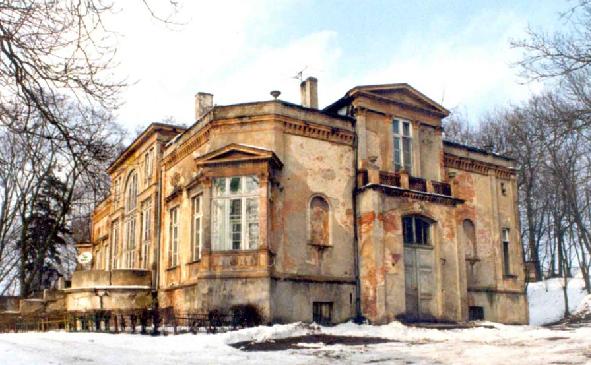
Estate Zankenzin, photo by Barbara Lewko, 1993
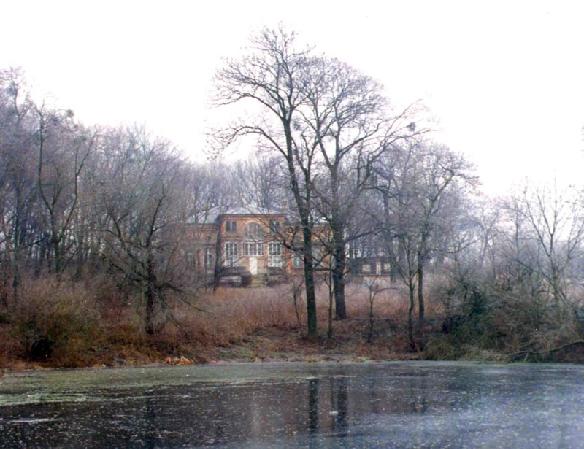
Estate Zankenzin, photo by Barbara Lewko, 1999
Schönfeld
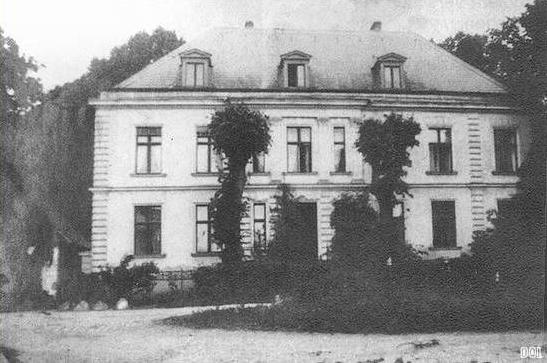
Estate Schönfeld, provided by Bartosz B.
Emaus
und Hölle
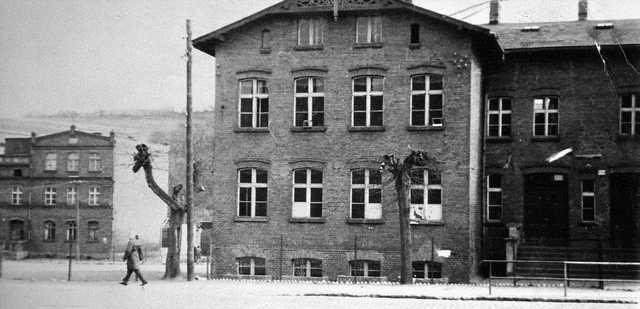
School Emaus
|
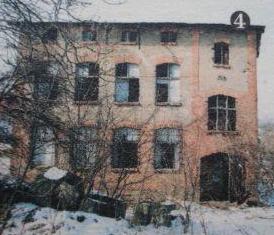
Ruin of the school Hölle
|
provided by Bartosz B.
Old Stories top
Bruno von Stolzenberg
...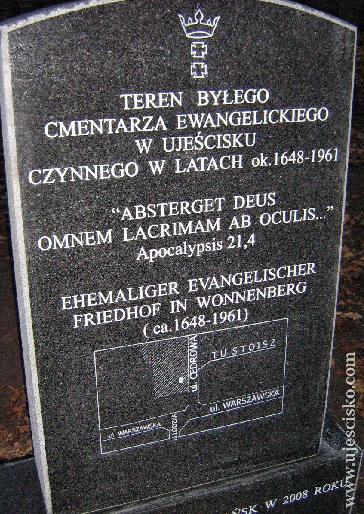 ... ... |
A monument was erected in remembrance of the former cemetery
in November 2008.
Inscription: ... Former protestant cemetery at Wonnenberg
...
This is a great gesture of the present inhabitants of
Wonneberg/Ujescisko.
This brings back memories:
As a seven year old boy I watched the funerals from the
street many times before 1945. Schucker-Brunchen (alias Bruno
von Stolzenberg) stood in the focus. I could watch him from a safe
distance. We feared him in the streets. The older children teased him,
so he chased all children and waved his walking stick.
It was said that Schucker-Brunchen was a former
priest. He was a bit confused. He visited *all* funerals in and around
Danzig/Gdansk and gave condolences. He lived from the small money he received
then.
Schucker-Brunchen became as Schugger Leo
a character of the world literature. He played an important underpart in
the novel Blechtrommel (The Tin Drum) by Günter Grass.
Grass: Near the end of World War II the number of funerals
had increased so much that even Schugger Leo lost the overview.
|
The
big pond
If you look for Wonneberg/ Ujescisko
on a map, you orientate by the big pond. It is a characteristic of the
village. -
Discussions in our family about
old times often deal with the pond. "My family" means my two elder brothers,
who were 15 and 16 years old, when we left Wonneberg. They helped me to
tell the following stories.
The big pond had no inflow and no
outflow and was filled by the surface water (rain). It was only about 80
cm deep. It was deeper in front of the street between the farmers Arthur
von Dühren and Prang, so that the horses could dip in for washing.
- The pond was the cattle watering tank. The horses were driven to the
North West corner every day in the morning, so that they could drink water.
They already were harnessed as teams to two or four. In the evenings also
the cows came to the ponds for drinking.
The youth didn't swim in the pond very often. The ground
was muddy and the water became easily dirty. The children learned how to
swim in a little pond North of Wonneberg in direction Hölle. You can
still see it on the Russian map above.
The children had many more activities:
Obviously the pond was biologically in balance, because
there lived fish, especially crucian carps. They caught the fish with a
special technique: They opened an empty paillasse with two sticks and then
two boys pulled it through the shallow water. Later on, when the fish were
fried, nobody wanted to eat them. They were full of bones and the mud gave
them a bad taste.
The winters were hard and long. The big pond was frozen
all winter. Skating was the favourite sport.
The carrousel was favoured: The older children drove
in a post in the centre of the pond. They fastened one end of a long rope
on the post. A skilled ice-skater took the other free end and made wide
circles with the tight rope. More ice-skater hold fast to the rope and
made circles with smaller radii. If someone had to let loose the rope,
he glided over the ice surface with applause by the others.
In January the slaughter from Emaus came to the pond and
cut out rectangular floes with an axe. He pulled them out of the pond,
shred them to smaller pieces, brought them with his lorry to his cellar
and cooled his meat products in warmer seasons. When the floes still lay
in the water, running on them was a favourite sport. Somebody jumped from
floe to floe and had to hit on the centre, so that the floe could carry
for a moment. It was dangerous to come under the ice surface. This happened
once with a boy from Neuwonneberg, who was rescued with difficulties. When
the slaughter left back a free water surface or during thaw, the children
formed bigger floes and used them as floats.
...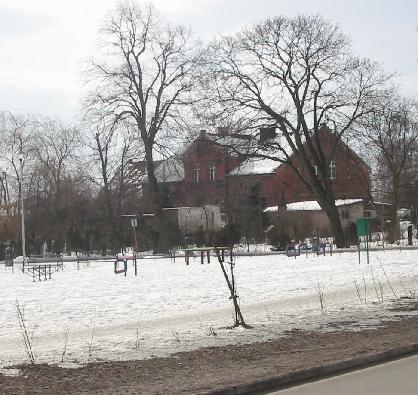 ...
2006. ...
2006.
|
When we visited Wonneberg/Ujescisko in March 2006, we
found a children's playground and some benches on the south east corner
in front of the former house of Mirau family (photo).
Before 1945 there was a fair with a roundabout and some
other amusement attractions every year on this place.
There was also the fire engine house.
This was the place, where the slaughter's lorry stood
for transporting the ice. |
New
Pictures top
Jacek Kalinowski sent me the following photos.
...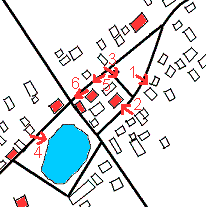 |
He combined old photos with new ones. |
1
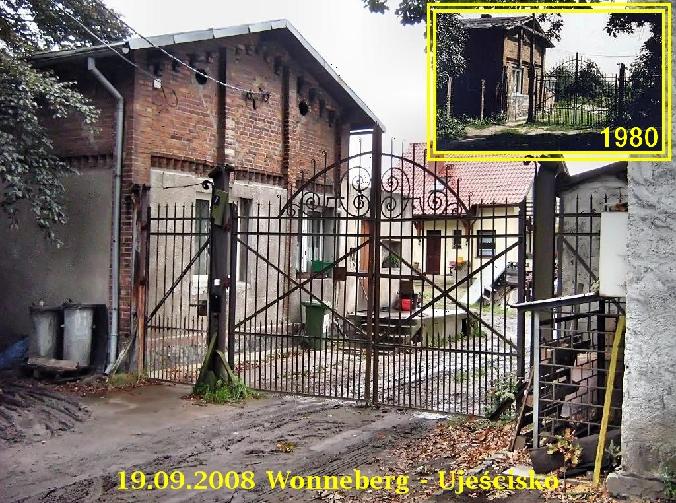
2
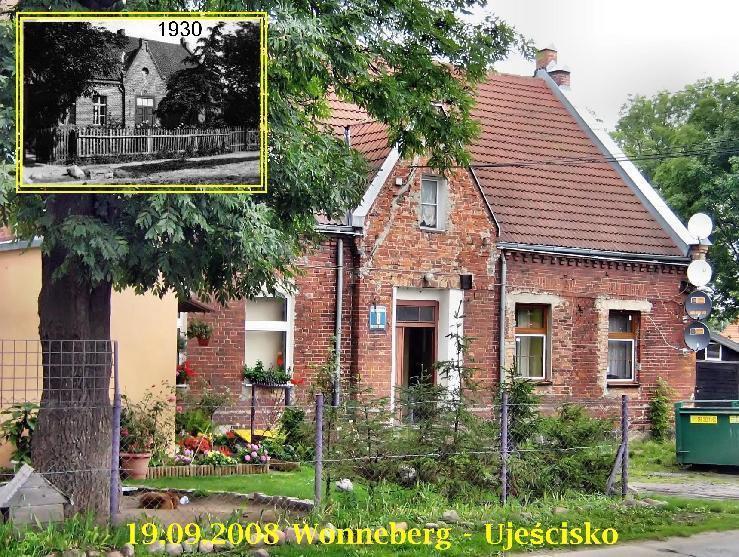
3
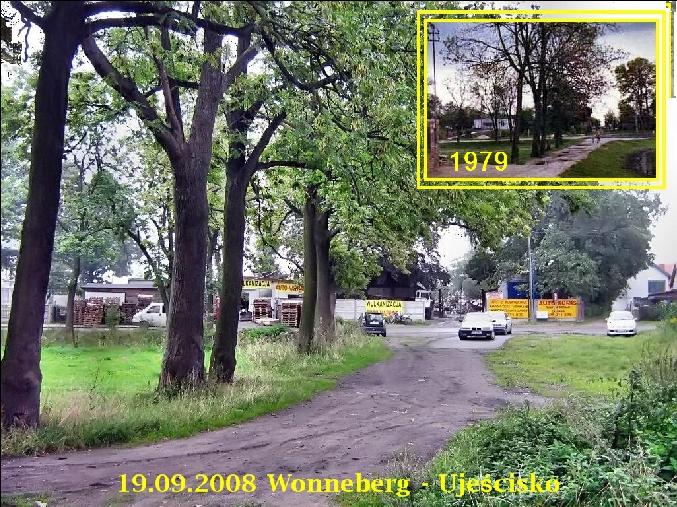
4
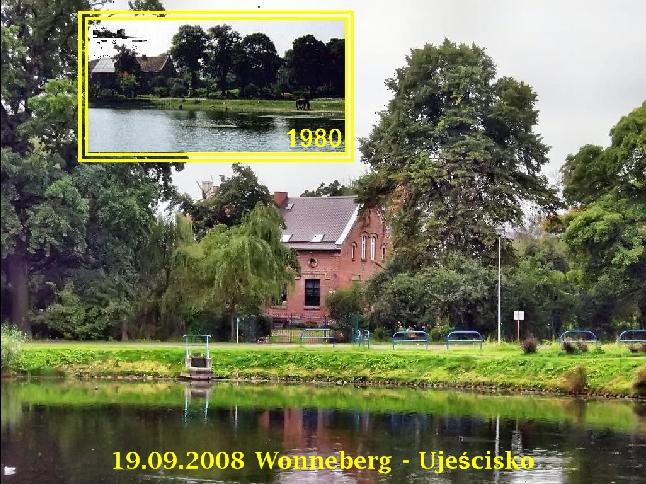
6
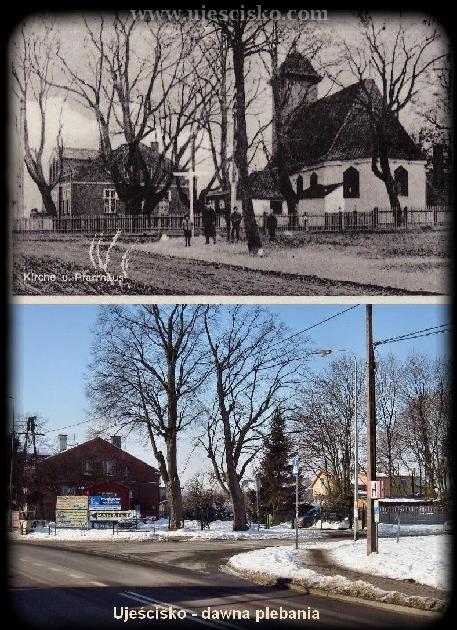
Vor 1942 und Februar 2009
|
5
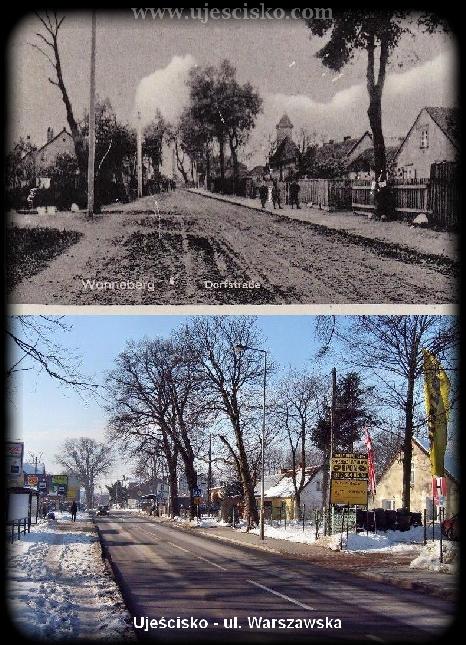 Vor 1942 und Februar 2009
Vor 1942 und Februar 2009
|

This is new to us: Water lilies on the big pond :-).
(Photo by Jacek Kalinowski, 2008)
There are many new houses
South of old Wonneberg/Ujescisko.
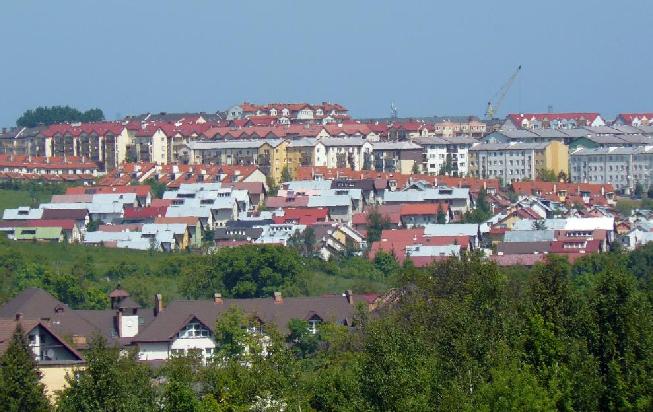
This is the settlement "Sztery pory roku" (Four Seasons)
in Zankenzin.
On the left and in the foreground there is a new school.
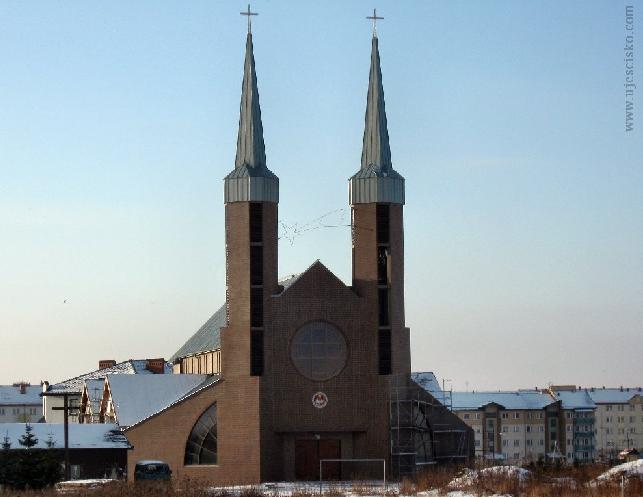
There is also the new Catholic church St. Padre Pio.
The spires are 35m high.
Danzig-Wonneberg/Gdansk-Ujescisko
on the Internet top
German
Axel Katins
Praust
Bund der Deutschen Minderheit Danzig
Bund
der Deutschen Minderheit Danzig / Zwiazek Mniejszosci Niemieckiej Gdansk
Geschichte
der Deutschen in Danzig nach 1945
forum.danzig.de
Schucker
Brunchen und Blum Antje, Eine
Erinnerung an Bruno (Schucker Brunchen)
Gdansk (https://www.gdansk.pl/de/)
list.genealogy.net
Heimatortskartei
- Liste der Filme bei den Mormonen
WESTPREUSSEN-ONLINE
Wikipedia
Ujescisko-Lostowice,
Danzig,
Freie
Stadt Danzig,
Ostgebiete
des Deutschen Reiches, Heimatvertriebener
Angerdorf,
Wilhelm
Gustloff (Schiff), Heimatortskartei
English
Gdansk (official
site)
Google
Streetview Wonneberg
Wikipedia
Ujescisko-Lostowice,
Gdansk,
Free
City of Danzig, Former
eastern territories of Germany, Heimatvertriebene,
Family
History Library (Mormon Church)
Polish
historia.trojmiasto.pl
Tak
wygladalo Ujescisko przed wojna (Google Übersetzer:
"Dies war der Vorkriegs Ujescisko")
Gdansk (official site)
naKole
W?ócz?ga
po ziemi che?mi?skiej (Eine Radtour durch Wonneberg)
Wikipedia
Ujescisko-Lostowice,
Ujescisko
Videos by
Jacek
Kalinowski at Youtube
Gdansk
Ujescisko... 20.06.2007
Cmentarz
Ujescisko - pokaz slajdów - 13.05.2008
Wonneberg
i Ujescisko... - 23. Febr. 2009
Ujesciska
Góra / Wonne-Berg - 24. Juli 2009
Z
albumów mieszkanców Ujesciska - 25.07.2010
Zima
- Ujescisko - 14.01.2010
Nowa
trasa tramwajowa / Neue Straßenbahn-Trasse - 11.05.2012
Feedback: Email address on my main page
This
page is also available in German.
URL of
my Homepage:
https://www.mathematische-basteleien.de/
©
2008, enlarged 2013, Jürgen Köller
top |


















 ...
... ...
... ...
... ...
...
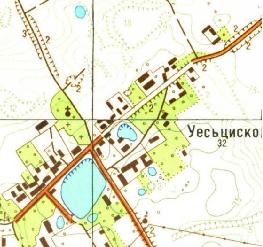 ...
... ...
... ....
.... ...
... ...
...

 ...
...

 ...
... ...
...

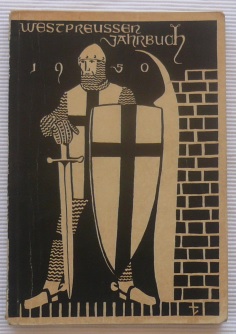
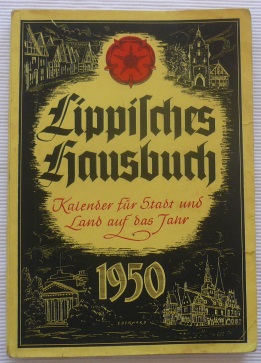

 ....
....

 ...
...






 ...
...
 ...
...
 ...
...
 ...
...


 ...
...


 ...
... ...
...


